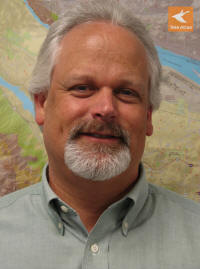 Recently Directions
editors Hal Reid and Joe Francica interviewed John Cassidy of Tele Atlas about the
company’s project to integrate Geographic Data Technology's
(GDT) data warehouse of digital streets and points of interest with
that of Tele Atlas (TA). The merger of these two companies 18 months
ago presented a huge challenge for both companies. Cassidy shed some
light on this undertaking.
Recently Directions
editors Hal Reid and Joe Francica interviewed John Cassidy of Tele Atlas about the
company’s project to integrate Geographic Data Technology's
(GDT) data warehouse of digital streets and points of interest with
that of Tele Atlas (TA). The merger of these two companies 18 months
ago presented a huge challenge for both companies. Cassidy shed some
light on this undertaking.Directions: The first issue that comes to mind when thinking about merging the Tele Atlas and GDT databases is the nature of the data. While both are considered world class, there is a perception that Tele Atlas has primarily first-hand data: data retrieved from the streets they have driven, address files, etc. GDT files, while collected from the field and other sources, may not be as accurate. GDT's strength may lie in geographic features. Is this the case or are there other factors that influenced the merger?
 |
Directions: You mentioned that the data merger has several benefits to Tele Atlas partners. Can you outline these?
JC: There are the qualities of combining the richness of GDT’s attributes and TA's positional accuracy, but perhaps the other key factors were, if there was "goodness in one dataset" it will be maintained in the combined data set.
Directions: What will most likely become the common data store going forward? Does this allow you to provide data in new formats like Oracle Spatial, for example?
JC: We’ve always been committed to whatever format the market is demanding. I can’t say that we are rushing to create a whole bunch of formats, but we are always prepared to offer what the customer wants. TA is delivering mostly .shp file format; MapInfo delivers to the .tab world.
Directions: As with most major data projects, there are things discovered that were never anticipated and that provide new enlightenment either in processes or products. Can you talk to some of these?
JC: There were no great revelations; a difficult job, but there were no unexpected discoveries. For example, about a year ago, the partners in the GIS market were briefed on the graphical conflation process on many levels. And once again, there was a geometry advantage in the TA dataset and attribution (advantage) with the GDT dataset. In addition to merging data, the GDT acquisition was made to expand the scope of our western world data. Mexico is the next phase of expansion and strengthened oversight of Asia.
Directions: In January, at a Radius Topology (Laser-Scan) release event in the UK, an interesting question was asked of the Tele Atlas people who were present: What happens to the data collected by Tele Atlas, and is this not a product in itself?
JC: We are looking at that possibility. There are so many possibilities. Things like expanding our address points and parcel maps. As an aside, regarding our existing products, we have found that this merging of data has generated more focus on our field data collection. The guys driving the streets feel that their efforts are now more focused. For example: just get only overpasses or other impedances. They also feel that there is a better combination of primary source and traditional data collection.
We do maintain a two-year rolling archive in every market where we operate and we rebuild the data models on a monthly basis. Our data models are also regional. Even so, we do have the ability to create one contiguous U.S. freeway file.
Directions: Tell us about your other markets beside traditional data for mapping software.
JC: We are serving a diversity of markets from retailing, to routing, to personal navigation and emergency response. Many types of users are being served. We have a policy in both products and markets where TA is taking great pride in being focused (on what we do) and we will not bring solutions to market that would put us at odds with our partners.
Directions: What are your thoughts on the SRC release of their geocoder as an open source product?
JC: I understand their motivations; I applaud them; I don’t see it as a bad thing. I think we need more geocoders that need to leverage global data sets.
Directions would like to thank John Cassidy for participating in the dialog and for giving us an insight into the elements of the merging of the GDT and Tele Atlas datasets.